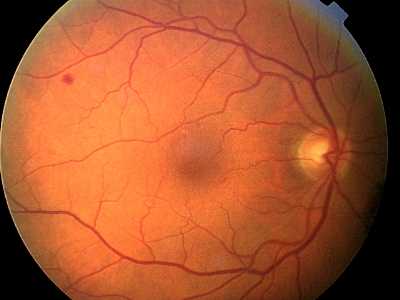
Screening for Diabetic Retinopathy
Diabetic retinopathy is a common serious, sight-threatening condition with a pre-symptomatic stage which can be easily detected and which is amenable to a therapy which is widely available and effective. Therefore, it satisfies the criteria for screening. Screening may be effected by dilated fundoscopy (by doctors or optometrists) or retinal photography. The method is unimportant; the crucial aspect is organisation.
It is recommended by all guidelines that diabetic patients are screened on an annual basis from diagnosis (although type 1, insulin-dependent, diabetics are unlikely to develop diabetic retinopathy within 5 years, irrespective of their glycaemic control). Screening should be increased if there are high risk co-morbidities such as pregnancy, renal failure or poorly controlled hypertension.
Examples of Retinopathy Appropriate for Annual Screening
# 1
Background diabetic retinopathy with a single blot haemorrhage in the temporal part of the fundus and some microaneurysms around the fovea. Visual acuity was 6/5 in this eye.
# 2
A single cotton wood spot towards the lower area of the picture and some associated dot/blot haemorrhages.
Steve Bain, Jon Gibson, Paul Dodson, Graham Sedgwick